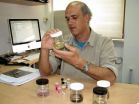(Press-News.org) A measles vaccine made of fine dry powder and delivered with a puff of air triggered no adverse side effects in early human testing and it is likely effective, according to a paper to be published November 28 in the journal Vaccine. The paper is now available online.
In 2013, measles killed 145,700 people, most of them children, according to the World Health Organization. That's despite the fact that the conventional injectable vaccine against the measles virus is effective.
"Delivering vaccines in the conventional way, with needle injections, poses some serious challenges, especially in resource-poor parts of the world," said Robert Sievers, co-author of the new paper, a fellow of the Cooperative Institute for Research in Environmental Sciences (CIRES) and also a professor in the University of Colorado Boulder's Department of Chemistry and Biochemistry.
His team innovated a dry delivery technique for the measles vaccine to eliminate the need for injections, liquid storage, and other challenges, such as vaccine contamination. "You don't need to worry about needles; you don't need to worry about reconstituting vaccines with clean water; you don't need to worry about disposal of sharps waste or other vaccine wastage issues; and dry delivery is cheaper," Sievers said.
The new paper represents the first successful Phase I clinical trial for a dry powder vaccine, he said. Sievers and his co-authors identified no adverse effects of the powdered and inhaled vaccine when tested in 60 healthy men who were already immune to measles. In this safety-focused clinical trial, they tested delivery with two devices--the Aktiv-Dry PuffHaler® and BD Technologies Solovent™--compared with the usual under-the-skin liquid injection method.
"Out of an abundance of caution, we test first in people who have already had the disease, or been injected earlier by needles with liquid vaccines," he explained. The men in all three groups responded similarly, with no clinically relevant side effects and some evidence of a positive immune response to vaccination. Because the men were already immune to the disease, this experiment could not yet compare effectiveness of the vaccines, measured by immune response. That will be the primary goal of follow-on Phase II/III pivotal trials.
"It is very good news that we encountered no problems, and now we can move on," Sievers said. The next phase of tests could include work in people who are not yet immune to measles, including women and children.
INFORMATION:
The authors of the new paper include researchers from the Serum Institute of India, Ltd., in Pune, India, which is the largest manufacturer of childhood vaccines used in developing countries; an Indian medical college; a North Carolina medical technology company; and the Georgia-based Centers for Disease Control and Prevention. Several of the authors also are affiliated with the Boulder company Aktiv-Dry, LLC, where Sievers is president and CEO.
In preclinical research, Sievers' team has already demonstrated that the vaccine protects rhesus macaques and cotton rats from infection by the measles virus. The researchers also have shown that their dry vaccines can be safely stored for 6 months to 4 years, at room temperature or in refrigerators kept at 36 to 46 degrees Fahrenheit (2-8 degrees Celsius), respectively.
This work was funded in part by a $20 million grant from the Foundation for the National Institutes of Health through the Grand Challenges in Global Health Initiative, which was created by the Bill and Melinda Gates Foundation.
CIRES is a partnership of CU-Boulder and the National Oceanic and Atmospheric Administration.
Treatment for obstructive sleep apnea with continuous positive airway pressure (CPAP) or mandibular advancement devices (MADs) can lead to modest improvements in depressive symptoms, according to a study published by Marcus Povitz, Carmelle Bolo, and colleagues from University of Calgary, Canada, in this week's PLOS Medicine.
The researchers identified 22 randomized controlled trials that investigated the effects of CPAP or MAD treatment on patients with obstructive sleep apnea and that measured depressive symptoms before and after treatment. By pooling the results from ...
HOUSTON - (Nov. 25, 2014) - An international collaboration of scientists including Baylor College of Medicine has completed the first genome sequence of a myriapod, Strigamia maritima - a member of a group venomous centipedes that care for their eggs - and uncovered new clues about their biological evolution and unique absence of vision and circadian rhythm.
Over 100 researchers from 12 countries completed the project. They published their work online today in the journal PLOS Biology.
"This is the first myriapod and the last of the four classes of arthropods to have ...
The arthropods are one of Earth's real success stories, with more species of arthropod than in any other animal phylum, but our knowledge of arthropod genomes has been heavily skewed towards the insects. Recent work has furnished us with the genome sequences of an arachnid and a crustacean, but the myriapods (centipedes and millipedes) have remained the one class of arthropods whose genomes are still in the dark.
An international team of scientists (over 100 from 15 countries) with Stephen Richards (Baylor College of Medicine) as senior author has now sequenced the genome ...
Centipedes, those many-legged creatures that startle us in our homes and gardens, have been genetically sequenced for the first time. In a new study in the journal PLoS Biology, an international team of over 100 scientists today reveals how this humble arthropod's DNA gave them new insight into how life developed on our planet.
Centipedes are members of the arthropods, a group with numerous species including insects, spiders and other animals. Until now, the only class of arthropods not represented by a sequenced genome was the myriapods, which include centipedes and ...
Learning-related brain activity in Parkinson's patients improves as much in response to a placebo treatment as to real medication, according to a new study by researchers at the University of Colorado Boulder and Columbia University.
Past research has shown that while Parkinson's disease is a neurological reality, the brain systems involved may also be affected by a patient's expectations about treatment. The new study, published in the journal Nature Neuroscience, explains how the placebo treatment -- when patients believe they have received medication when they have ...
Endangered Snake River sockeye salmon are regaining the fitness of their wild ancestors, with naturally spawned juvenile sockeye migrating to the ocean and returning as adults at a much higher rate than others released from hatcheries, according to a newly published analysis. The analysis indicates that the program to save the species has succeeded and is now shifting to rebuilding populations in the wild.
Biologists believe the increased return rate of sockeye spawned naturally by hatchery-produced parents is high enough for the species to eventually sustain itself in ...
MAYWOOD, Il. - An award-winning study by a Loyola University Chicago Stritch School of Medicine researcher has documented how homeless, mentally ill women in India face a vicious cycle:
During psychotic episodes, they wander away from home, sometimes for long distances, and wind up in homeless shelters. They then are returned to their families before undergoing sufficient psychosocial rehabilitation to deal with their illness. Consequently, they suffer mental illness relapses and wind up homeless again.
"The study illustrates how there must be a balance between reintegrating ...
While the turkey you eat on Thursday will bring your stomach happiness and could probably kick-start an afternoon nap, it may also save your life one day.
That's because the biological machinery needed to produce a potentially life-saving antibiotic is found in turkeys. Looks like there is one more reason to be grateful this Thanksgiving.
"Our research group is certainly thankful for turkeys," said BYU microbiologist Joel Griffitts, whose team is exploring how the turkey-born antibiotic comes to be. "The good bacteria we're studying has been keeping turkey farms healthy ...
How is it that vultures can live on a diet of carrion that would at least lead to severe food-poisoning, and more likely kill most other animals? This is the key question behind a recent collaboration between a team of international researchers from Denmark's Centre for GeoGenetics and Biological Institute at the University of Copenhagen, Aarhus University, the Technical University of Denmark, Copenhagen Zoo and the Smithsonian Institution in the USA. An "acidic" answer to this question is now published in the scientific journal Nature Communications.
When vultures eat ...
Who knew Blu-ray discs were so useful? Already one of the best ways to store high-definition movies and television shows because of their high-density data storage, Blu-ray discs also improve the performance of solar cells -- suggesting a second use for unwanted discs -- according to new research from Northwestern University.
An interdisciplinary research team has discovered that the pattern of information written on a Blu-ray disc -- and it doesn't matter if it's Jackie Chan's "Supercop" or the cartoon "Family Guy" -- works very well for improving light absorption across ...

